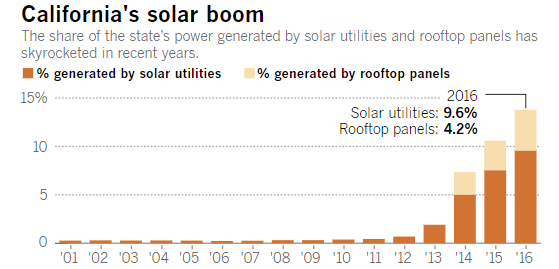
We all know why the world needs solar panels.
Solar-powered photovoltaic (PV) panels are popular for converting natural sunlight into electricity that we use in our homes, public spots, and offices.
It is environmentally friendly. It means by using this power you won’t create any pollution since we’re not getting electricity by burning fossil fuels. It also reduces your electricity bills and is a low-maintenance option.
Besides this, sunlight is a form of renewable energy which means that we’ll never run out of it.
According to the solar energy stats, the entire US had 64.2 GW of installed solar panels that are enough to power up 12.3 million homes.
Solar panels are considered as energy-efficient because they don’t require fossil fuels.
While digital computer technologies are bringing immense security to routine processes, there are a lot of things that are yet to be covered. One of them is handling the challenges that come with using solar panels for energy generation.
Challenges that come with solar panel electricity generation
Here are a few challenges that can hold authorities back from maximizing the potential of solar energy:
- The installation is costly
People might assume that while everyone has free access to the sun, electricity should be free. But this is not the case since investment in solar electricity is pricey.
According to the predictions by Energy Information Administration (EIA), solar electricity is the most expensive type of power generation tech. It cost about $369 per megawatt-hour for PV.
This is just a large-scale analysis. Small installations on the rooftops of homeowners are more expensive because people don’t buy in bulk like companies. For an average-size installation, the cost ranges from $11,144 to $14,69 while the average price per watt ranges from $2.51 to $3.31 (EnergySage).
How can you save money?
- Try a solar-saving calculator
- Get multiple quotes and compare providers that offer the best service at the lowest cost.
- Differences in solar intensity
One of the key hurdles to the production of electricity by solar panels is the differences in solar intensity.
According to a report published by the National Renewable Energy Laboratory, the sun provides almost twice as much temperature to the Sub-Saharan Desert as it does to the Pacific Northwest.

Because a panel’s result is highly influenced by the temperature it receives and the semiconductor material, this means that a solar panel will work much better in deserts than in other parts of the region. Similarly, the efficiency of the solar panels declines as the temperature drops.
It is certainly a huge challenge for companies as it is an uncontrollable factor. While solar panels can provide free energy in some parts of the country, the same solar panels will take much longer to pay for themselves in areas without strong solar coverage.
- Operation management and monitoring
Operation management and maintenance of solar panel sites are necessary to guarantee optimal return on investment (ROI) and avoid potentially dangerous situations that can cause losses.
Generally, operations include remote monitoring and controlling of the power plants. The monitoring software is fully secured and provides access to the data which can be used for identifying loopholes, detecting, performance evaluation, need for maintenance, and security.
At this moment, we lack an effective monitoring system that does all of this. A good system provides information related to solar power generation and offers analytical data and warnings in a timely manner.
- Grid infrastructure in the US
Over the past century, the grid infrastructure in the country remained the same. So it doesn’t matter if you and I try to go greener because the widespread grid infrastructure is not ready to handle renewable energy.
Why does it matter?
Solar electricity cannot be stored in the grid structure. You might think why does it matter when led outdoor flood light bulbs consume less electricity?
It matters for some reasons. Once it is generated it will be transmitted to the grids that supply the electricity to the nation.
The power in your office might flicker or go out fully if the overall demand exceeds the supply. On the flip side, the power will be wasted if the amount of power generation exceeds the demand. To prevent this from happening, the right balance needs to be created between power production and consumption.
Flexible grid systems with high storage capacity can motivate consumers to shift to solar tech.
- The issues with oversupply
As people get to know about the numerous benefits of solar electricity, solar investment plunges over the past years.
Would you believe if I tell you that the US state of California invested so heavily in solar power that it is now paying other US states to buy from it?

Solar panel companies rushed to produce materials and components needed for the large-scale production of renewable electricity. Even with high demand in the solar industry, the huge number of manufacturers that jumped into the marketed lead to an oversupply of solar panels.
Even in China, serious oversupply and low utilization rates become a political debate. So many companies go out of business because of the overgrown supply demand. However, this benefitted the buyers as it drives down the cost of the system.
Still, investors lose millions. This is a major reason why investors are now hesitant to invest in solar energy. Without their input, there will be a lack of development in solar tech, and it may also hinder its adoption in the long run.
- Environmental effects
Lighting up your homes with solar electricity is believed to be emission-free, but it is not.
According to essay writers in the UK, the manufacturing of solar panels involves substances that are not eco-friendly. A common by-product is Nitrogen Trifluoride which is used in electronic products. Plus, there are other unfriendly substances that are used in solar cells and generate 17,000 times more greenhouse gas emissions.
A lot of solar cells also include tiny metal particles of Cadmium and toxic batteries that are used to store electricity also contain dangerous metals like Copper, Nickel, Gallium, and Tin.
Technology is the answer
As technologies for solar panel manufacturing improve, industrialists may be able to move away from potentially hazardous chemicals and metals. But for now, solar panels are still the safest option we have for powering up our life.
Key takeaway
Electricity production through solar panels is one of the most promising technologies that we have. Generating light from the inexhaustible free sun is indeed a sustainable option. It offers immense benefits to companies and individual households but reality is the same as we expect it to be.
Currently, solar faces a number of barriers that stop the nation from switching from fossil fuel completely. I personally believe that advanced technology and a true dedication to going green is the answer to combat all the above-mentioned challenges.
New technologies can lower the cost of solar panel production, and installation of the system, and improve the transmission infrastructure. Plus, technologies can help companies identify the real demand so that solar panels will not go to waste.
Author bio

Liza Brooke is currently working as a Sr. Research Analyst & Tech Blogger at Crowd Writer, a reliable online platform that offers writing services in diverse niches. Her strength lies in creating appealing tag lines and captions for videos, images, and text content. She engages with entrepreneurs actively.



Leave a Reply